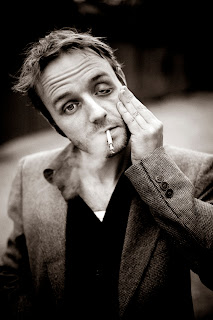About 10 years ago, I put a copy of Morton Subotnick's Silver Apples of the Moon on hold at a used record store in New Jersey. I've avoided picking it up mostly because I like the idea of it still being nestled away somewhere, forgotten by everyone. Devendra Banhart's title Golden Apples of the Sun neatly references the final line from W.B. Yeats' "The Song of Wandering Angus", where it's paired with those silver moon apples. ("And pluck till time and times are done/ The silver apples of the moon/ The golden apples of the sun.") It's also an album by Judy Collins, a collection of stories by Ray Bradbury, and a low-budget 1971 film about violence and hippies. But perhaps Banhart chose the title to contrast directly with Subotnick's famously chilly modulations, because even while this compilation functions as a kind of now-sound capsule of the contemporary neo-folk scene, its best artists share an anachronistic, misfiled air with Subotnick's dusty gem, patiently awaiting discovery.
Whatever the title's derivation, as head curator, Banhart assumes the tricky role of scene definer. I can't imagine the man behind "This Beard Is for Siobhan" subscribing to locked-door scenesterism, but Golden Apples of the Sun draws a clean line in the sand. Unlike Brian Eno, who kept his No New York sampler to just four acts, the bearded bard here musters a generous spread of 20 diverse freakfolk acts to serve as representatives of the various facets of the underground's most recent (and most promising) pigeonhole. Not intended to flood the market, Golden Apples of the Sun is limited to 1,000 copies and can only be had through Arthur magazine, which released the disc on its newly founded Bastet imprint.
For this disc, Banhart wisely pairs spankin' new tracks with a number of previously released ones. In an interesting change of pace from most compilations, however, the non-exclusive cuts are the real draw here, and they greatly benefit from both Banhart's careful sequencing and separation from their original full-lengths. Saddled between two downcast instrumentals, Little Wings' "Look at What the Light Did Now" absolutely sparkles. Kyle Field owns a preternaturally heartbreaking (and charmingly off-key) voice even at his happiest, and here, outside the context of his spotty K Records albums, his syllables are remarkably affecting. Viking Moses also kicks it Little Wings-style; his "Crosses" (from the album of the same name) displays a pawnshop sweetness: "Without love, life is gone/ Without life, love goes on and on."
Golden Apples' shifts in gradation keeps the narrative from stalling-out: Espers' "Byss & Abyss" balances boy/girl contrast with just the right amount of Philly opiate haziness; six-stringer Jack Rose ups the finger-picking ante with the careening notes of "White Mule" from his Red Horse, White Mule; Iron & Wine beautifully represent for soft strums with "Fever Dream" from their hugely popular Our Endless Numbered Days; and Banhart himself shows up dueting with folk legend Vashti Bunyan on the title track of his recent masterstroke, Rejoicing in the Hands.
Anti-folk singer/songwriter and nutritionist Diane Cluck's "Heat from Every Corner" (from Macy's Day Bird) comes complete with ambient footsteps and a click of the off switch, and sounds as though it was placed on tape by Chan Marshall 40 years ago. Current 93 collaborator and one of NYC's most compelling voices, Antony, closes out the disc in style with a musical interpretation of Edgar Allan Poe's "The Lake", featuring his signature heart-rending, androgynous operatics and mesmerizing piano. (If you're unfamiliar with his work, check out the I Fell in Love with a Dead Boy EP and be blown away by the brilliant camp heartache.)
Displacement breathes life into Currituck Co.'s "The Tropics of Cancer", a smiling but subdued acoustic instrumental from the often enjoyable Ghost Man on First, while Vetiver turn in "Angel's Share", a collaboration with Mazzy Star's Hope Sandoval that marked the standout on their self-titled debut. White Magic's "Don't Need" isn't the most riveting track from the Brooklyn trio's Drag City debut, but this meandering twanger makes more sense in the compilation's context than any of Through the Sun Door's witchier tracks.
Meanwhile, inherently strong numbers continue to shine: Joanna Newsom's "Bridges and Balloons" feels just as triumphant torn from The Milk-Eyed Mender. It functions as a lead-in for Six Organs of Admittance's "Hazy SF", a wee ditty that swims in the suave-dude realm of Compathia rather than the gorgeous spaciousness of the recently reissued gem For Octavio Paz.
The real treats, however, come courtesy of two lesser-known acts. Chicago's
Josephine Foster (of Born Heller and The Children's Hour) rustles backwoods memories amid banjo, flute, and the indescribable air of English romanticism on the unreleased home recording "Little Life". It's a stunning fragment: Shirley Collins collides with and bows gently within the cleansing mud of a rocky stream. Likewise, ex-Matty & Mossy vocalist Jana Hunter blows the roof off the barn with "Farm, CA", a section of hauntingly whispered lo-fi dreaminess.
Not everything here achieves the understated power of these aforementioned tracks, but Golden Apples of the Sun's sprawling landscape presents a persuasive case for the depth of a scene that seemingly sprung up (like mushrooms) overnight. It's impossible to pick apart intentions, but this music feels far more sincere than other recent buzzes, and even if these artists are pulling the wool over our eyes (which seems unlikely), it would appear that perhaps a few of these players will outlast the current critical harvesting. To see if I'm right, hide this disc in your bedroom after one listen and wait a decade before that second date.
©
Ask for download link in comments.

















.jpg)


